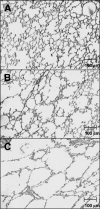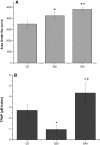Lung injury-dependent oxidative status and chymotrypsin-like activity of skeletal muscles in hamsters with experimental emphysema
- PMID: 23343460
- PMCID: PMC3560156
- DOI: 10.1186/1471-2474-14-39
Lung injury-dependent oxidative status and chymotrypsin-like activity of skeletal muscles in hamsters with experimental emphysema
Abstract
Background: Peripheral skeletal muscle is altered in patients suffering from emphysema and chronic obstructive pulmonary disease (COPD). Oxidative stress have been demonstrated to participate on skeletal muscle loss of several states, including disuse atrophy, mechanical ventilation, and chronic diseases. No evidences have demonstrated the occurance in a severity manner.
Methods: We evaluated body weight, muscle loss, oxidative stress, and chymotrypsin-like proteolytic activity in the gastrocnemius muscle of emphysemic hamsters. The experimental animals had 2 different severities of lung damage from experimental emphysema induced by 20 mg/mL (E20) and 40 mg/mL (E40) papain.
Results: The severity of emphysema increased significantly in E20 (60.52 ± 2.8, p < 0.05) and E40 (52.27 ± 4.7; crossed the alveolar intercepts) groups. As compared to the control group, there was a reduction on body (171.6 ± 15.9 g) and muscle weight (251.87 ± 24.87 mg) in the E20 group (157.5 ± 10.3 mg and 230.12 ± 23.52 mg, for body and muscle weight, respectively), which was accentuated in the E40 group (137.4 ± 7.2 g and 197.87 ± 10.49 mg, for body and muscle weight, respectively). Additionally, the thiobarbituric acid reactive substances (TBARS), tert-butyl hydroperoxide-initiated chemiluminescence (CL), carbonylated proteins, and chymotrypsin-like proteolytic activity were elevated in the E40 group as compared to the E20 group (p < 0.05 for all comparisons). The severity of emphysema significantly correlated with the progressive increase in CL (r = -0.95), TBARS (r = -0.98), carbonyl proteins (r = -0.99), and chymotrypsin-like proteolytic activity (r = -0.90). Furthermore, augmentation of proteolytic activity correlated significantly with CL (r = 0.97), TBARS (r = 0.96), and carbonyl proteins (r = 0.91).
Conclusions: Taken together, the results of the present study suggest that muscle atrophy observed in this model of emphysema is mediated by increased muscle chymotrypsin-like activity, with possible involvement of oxidative stress in a severity-dependent manner.
Figures




Similar articles
-
Oxidative and proteolysis-related parameters of skeletal muscle from hamsters with experimental pulmonary emphysema: a comparison between papain and elastase induction.Int J Exp Pathol. 2015 Jun;96(3):140-50. doi: 10.1111/iep.12121. Epub 2015 Jun 22. Int J Exp Pathol. 2015. PMID: 26102076 Free PMC article.
-
Oxidative status and chymotrypsin-like activity in right and left ventricle hypertrophy in an experimental model of emphysema.Pathophysiology. 2013 Sep;20(4):249-56. doi: 10.1016/j.pathophys.2013.08.003. Epub 2013 Oct 19. Pathophysiology. 2013. PMID: 24149056
-
[Reduction of muscle mass mediated by myostatin in an experimental model of pulmonary emphysema].Arch Bronconeumol. 2011 Dec;47(12):590-8. doi: 10.1016/j.arbres.2011.07.008. Epub 2011 Nov 5. Arch Bronconeumol. 2011. PMID: 22056524 Spanish.
-
Redox Control of Proteolysis During Inactivity-Induced Skeletal Muscle Atrophy.Antioxid Redox Signal. 2020 Sep 10;33(8):559-569. doi: 10.1089/ars.2019.8000. Epub 2020 Feb 24. Antioxid Redox Signal. 2020. PMID: 31941357 Free PMC article. Review.
-
Oxidative stress and disuse muscle atrophy: cause or consequence?Curr Opin Clin Nutr Metab Care. 2012 May;15(3):240-5. doi: 10.1097/MCO.0b013e328352b4c2. Curr Opin Clin Nutr Metab Care. 2012. PMID: 22466926 Free PMC article. Review.
Cited by
-
Alteration of antioxidant enzymes and associated genes induced by grape seed extracts in the primary muscle cells of goats in vitro.PLoS One. 2014 Sep 19;9(9):e107670. doi: 10.1371/journal.pone.0107670. eCollection 2014. PLoS One. 2014. PMID: 25238394 Free PMC article.
-
Protective effect of edaravone for tourniquet-induced ischemia-reperfusion injury on skeletal muscle in murine hindlimb.BMC Musculoskelet Disord. 2013 Mar 27;14:113. doi: 10.1186/1471-2474-14-113. BMC Musculoskelet Disord. 2013. PMID: 23530927 Free PMC article.
-
Animal Models Reflecting Chronic Obstructive Pulmonary Disease and Related Respiratory Disorders: Translating Pre-Clinical Data into Clinical Relevance.J Innate Immun. 2020;12(3):203-225. doi: 10.1159/000502489. Epub 2019 Sep 17. J Innate Immun. 2020. PMID: 31527372 Free PMC article. Review.
-
Oxidative and proteolysis-related parameters of skeletal muscle from hamsters with experimental pulmonary emphysema: a comparison between papain and elastase induction.Int J Exp Pathol. 2015 Jun;96(3):140-50. doi: 10.1111/iep.12121. Epub 2015 Jun 22. Int J Exp Pathol. 2015. PMID: 26102076 Free PMC article.
-
Lifelong dietary protein restriction induces denervation and skeletal muscle atrophy in mice.Free Radic Biol Med. 2024 Nov 1;224:457-469. doi: 10.1016/j.freeradbiomed.2024.09.005. Epub 2024 Sep 6. Free Radic Biol Med. 2024. PMID: 39245354 Free PMC article.
References
-
- Marquis K, Debigaré R, Lacasse Y, LeBlanc P, Jobin J, Carrier G, Maltais F. Midthight musclr cross-sectional área is a better predictor of mortality than body mass index in patients with chronic obstructive pulmonary disease. Am J Respir Crit Care Med. 2002;166(6):809–813. doi: 10.1164/rccm.2107031. - DOI - PubMed
-
- Gosselink R, Troosters T, Decramer M. Peripheral muscle weakness contributes to exercise limitation in COPD. Am J Respir Crit Care Med. 1996;153(3):976–980. - PubMed
Publication types
MeSH terms
Substances
LinkOut - more resources
Full Text Sources
Other Literature Sources
Research Materials

